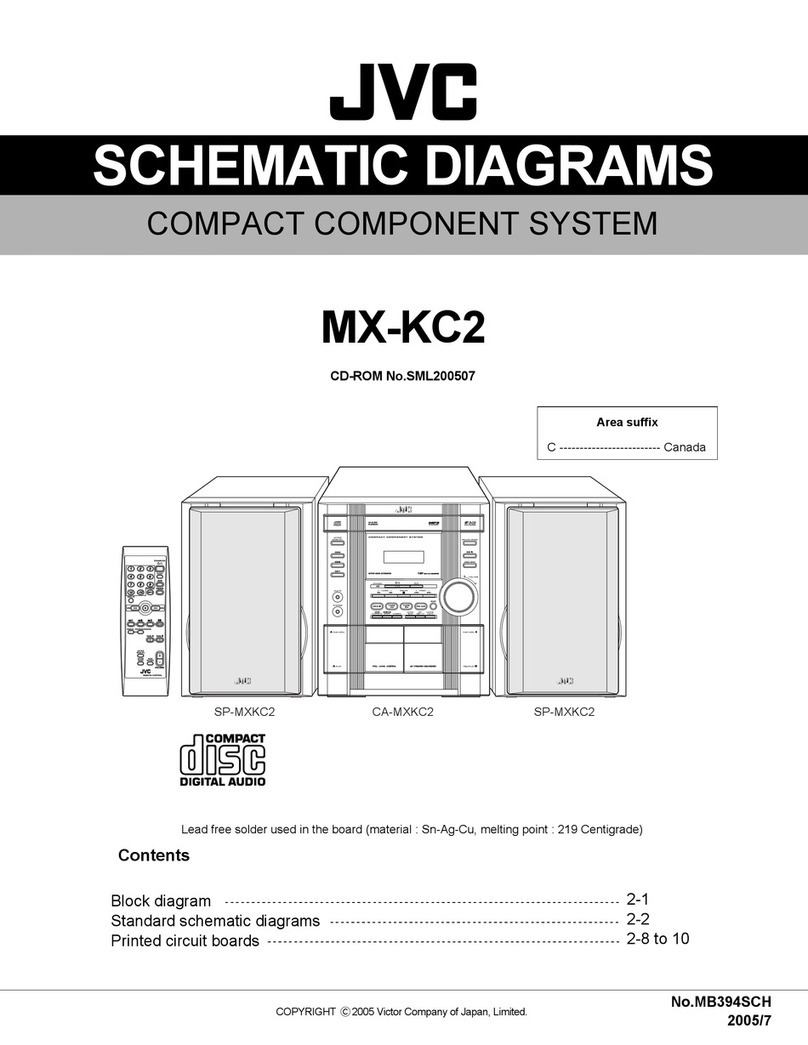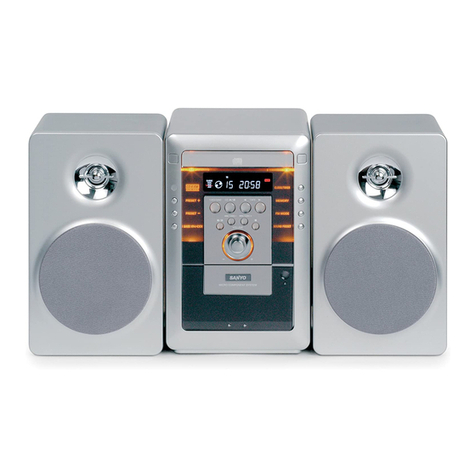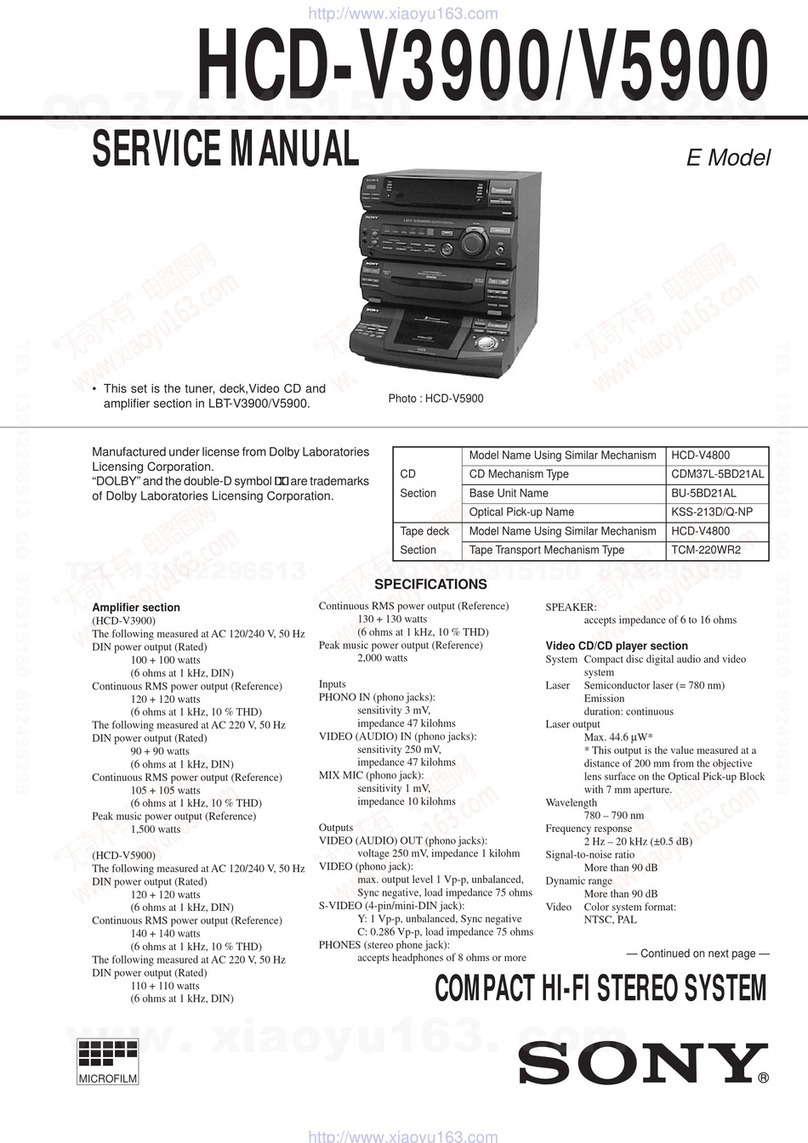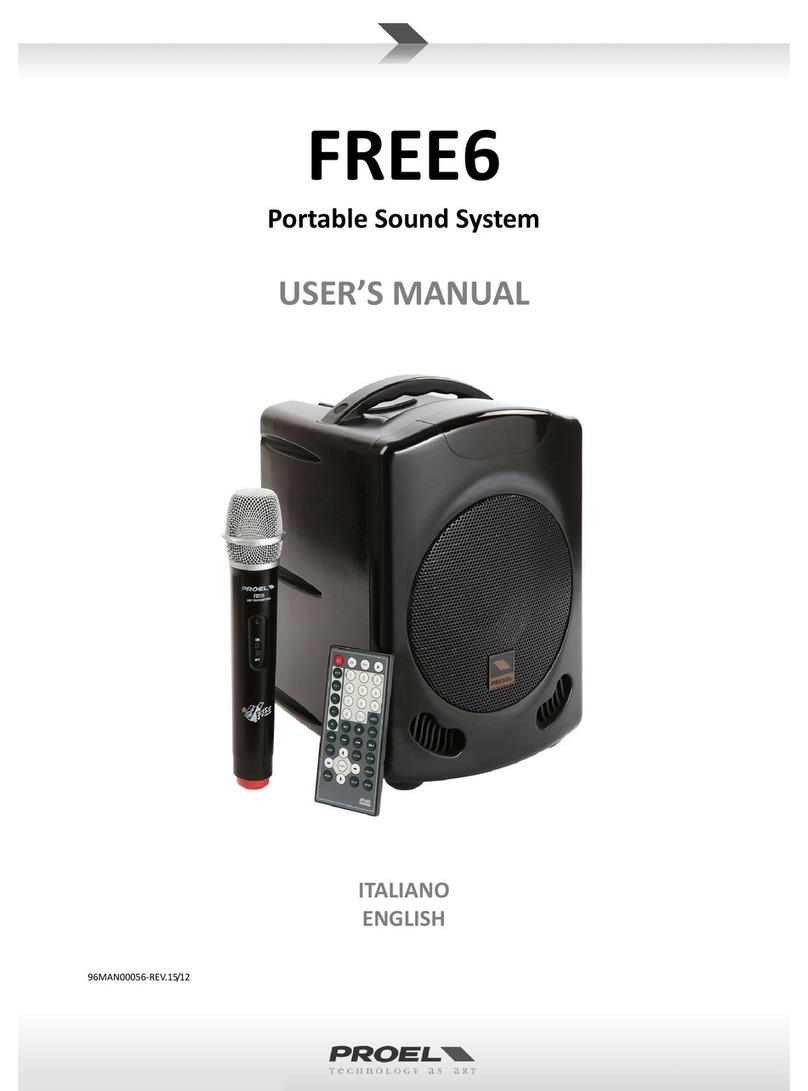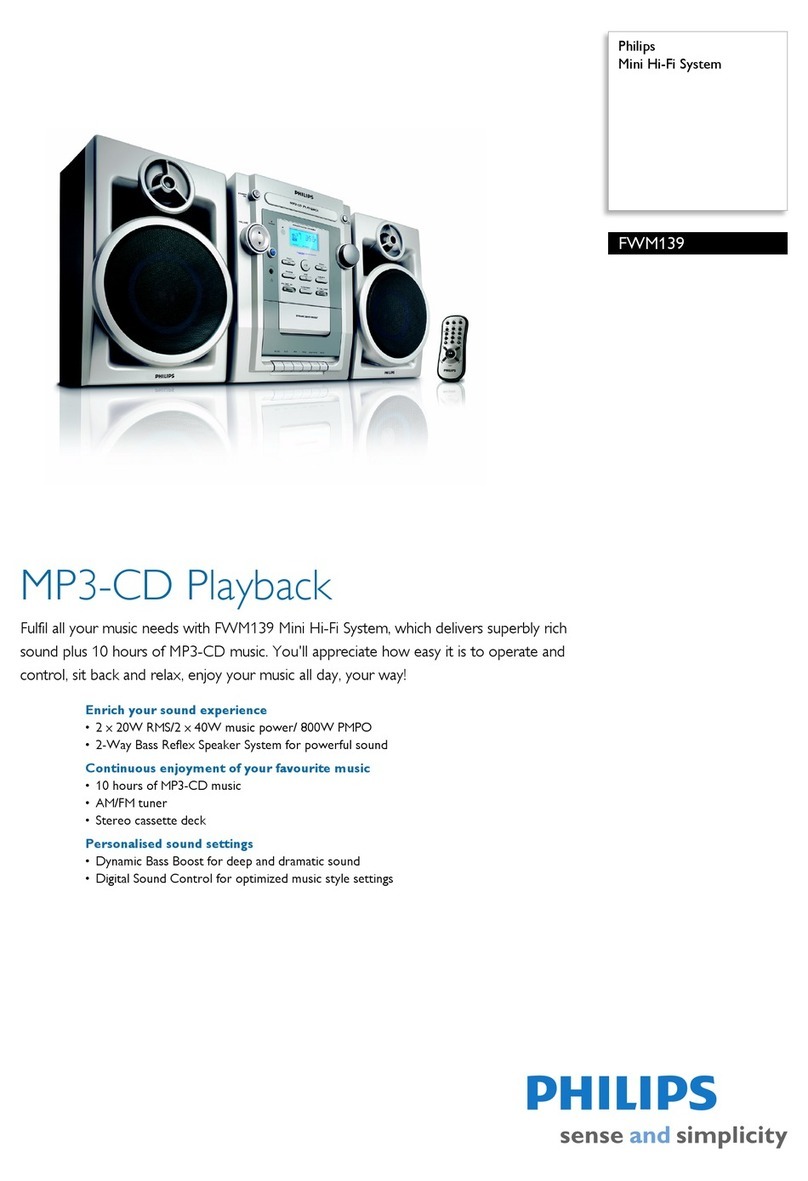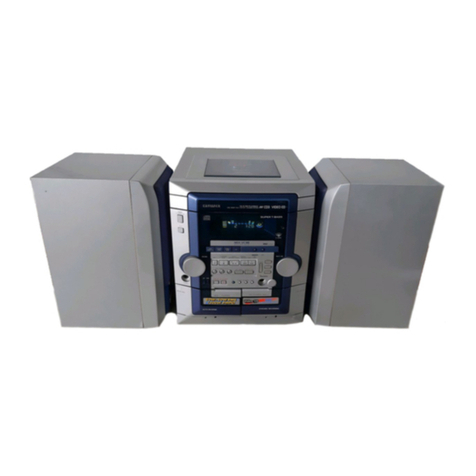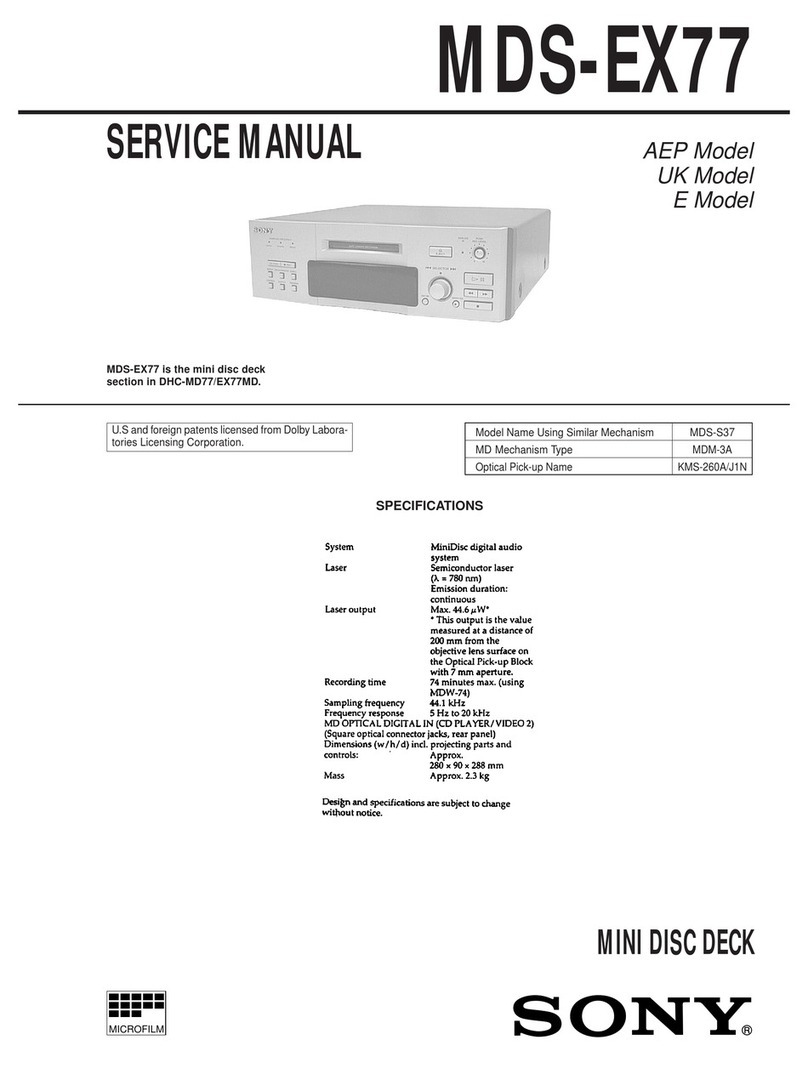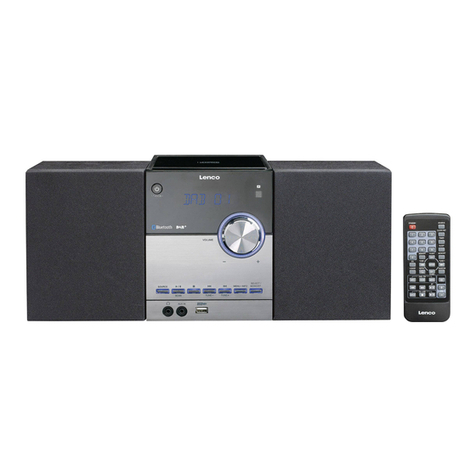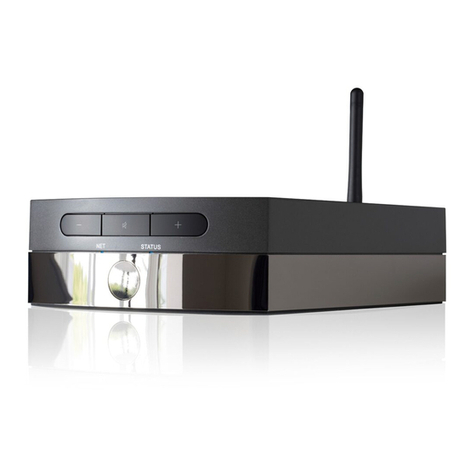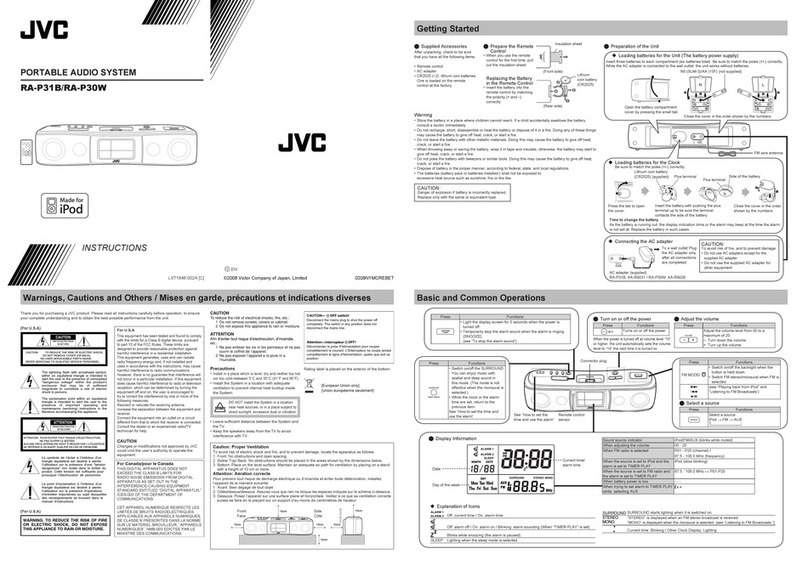R.V.R. Elettronica HC5 User manual

Manufactured by Italy
HC5
UserManual
LCD version

HC5-UserManual
Version 1.0
© Copyright 2002
R.V.R.Elettronica SpA
Via del Fonditore 2/2c - 40138 - Bologna (Italia)
Telefono: +39 051 6010506
Fax: +39 051 6011104
Email: info@rvr.it
Web: www.rvr.it
Allrightsreserved
PrintedandboundinItaly. No part of this manual may be reproduced,
memorized or transmitted in any form or by any means, electronic or
mechanic, including photocopying, recording or by any information
storageandretrievalsystem,withoutwrittenpermissionofthecopyright
owner.
File name: HC5LCD10_EN.P65
Version: 1.0
Date: 11/02/2002
Revision History
1.0 11/02/2002 New version D. Canazza
Version Date Reason Editor

HC5
iUserManual Rev.1.0L- 11/02/02
Table of Content
1. Preliminary instructions 1
2. Warranty 3
3. First Aid 5
3.1 Treatment of electrical shocks 5
3.2 Treatment of electrical Burns 6
4. General Desciption 7
5. Installation and use 9
5.1 Preparation 9
5.2 Operation 9
5.3 Software 10
6. Controls, Indicators and Connectors 19
6.1 Front Panel 19
6.2 Rear Panel 20
6.3 Connectors Description 21
7. Technical Specifications 23
7.1 Dimensional and Environmental Specifications 23
7.2 Electrical Specifications 23
8. Electrical description 25
8.1 Modules Identificarion (upper view) 25
8.2 Modules Identificarion (bottom view) 26
9. Theory of Operation 27
9.1 Power supply 27
9.2 Power Splitter 27
9.3 Power Combiner 27
9.4 Remote Card 28
9.5 CPU 28
9.6 Telemetry board 28
9.7 Adjustment 28
10. Maintenance Procedures 31
10.1 Introduction 31
10.2 Safety Consideration 31
10.3 Routine Maintenance 31
10.4 Cards Replacement 31
11. Calibration Procedures 33
11.1 Introduction 33
11.2 CPU Assembly Adjustment 33
Appendix
Component layouts, schematics, bills of material

HC5
ii UserManualRev.1.0L- 11/02/02
This page was intentionally left blank

HC5
1 / 34User Manual Rev. 1.0L - 11/02/02
1. Preliminary instructions
This manual is written as a general guide for those having previous knowledge
and experience with this kind of equipment.
It is not intended to contain a complete statement of all safety rules which should
be observed by personnel in using this or other electronic equipment.
The installation, use and maintenance of this piece of equipment involve risks
both for the personnel performing them and for the device itself, that shall be used
only by trained personnel.
R.V.R. doesn’t assume responsibility for injury or damage resulting from improper
procedures or practices by untrained/unqualified personnel in the handling of this
unit.
Please observe all local codes and fire protection standards in the operations of
this unit.
WARNING: always disconnect power beforeopening coversorremovingany part
of this unit.
Use appropriate grounding procedures to short out capacitors and high voltage
points before servicing.
WARNING: This is a "CLASSA" equipment. In a residential place this equipment
can cause hash. In this case can be requested to user to take the necessary
measures.
R.V.R. Elettronica SpA reservesthe right to modify the design and/or the technical
specifications of the product and this manual without notice.

HC5
2 / 34 User ManualRev. 1.0L - 11/02/02
This page was intentionally left blank

HC5
3 / 34User Manual Rev. 1.0L - 11/02/02
2. Warranty
Any product of R.V.R. Elettronica is covered by a 12 (twelve) month warranty.
Forcomponentsliketubesforpoweramplifiers, theoriginalmanufacturer’swarranty
applies.
R.V.R. extends to the original end-user purchaser all original manufacturers
warranties which are transferable and all claims are to be made directly to R.V.R.
per indicated procedures.
R.V.R.'s warranty shall not include:
1) Re-shipment of the unit to R.V.R. for repair purposes
2) Any unauthorized repair/modification
3) Incidental/consequential damages as a result of any defect
4) Nominal non-incidental defects
5) Re-shipment costs or insurance of the unit or replacement units/parts
Warranty shall come into force from invoice date and for the period of the
manufactures warranty.
Anydamagetothe goods must be reported to thecarrier in writingon the shipment
receipt.
Any discrepancy or damage discovered subsequent to delivery, shall be reported
to R.V.R. within five (5) days from its receipt.
To claim your rights under this warranty:
a. Contact the dealer or distributor where you purchased the unit. Describe the
problemandask ifhehasan easysolution.DealersandDistributors aresupplied
with all the information aboutproblems that may occur and usually they can
repairthe unit quicker than what the manufacturer could do. Very ofteninstalling
errors are discovered by dealers.
b. If your dealer cannot help you, contact R.V.R. in Bologna and explain the
problem. If it is decided to return the unit to the factory, R.V.R. will mail you a
regularauthorizationwithallthenecessaryinstructionstosendbackthe goods.
c. When you receive the authorization, you can return the unit. Pack it carefully
for the shipment, preferably using the original packing and seal the package
perfectly. The customer always assumes the risks of loss (i.e., R.V.R. is never
responsible for damage or loss), until the package reaches R.V.R. premises.
For this reason, we suggest you to insure the goods for the whole value.
Shipmentmustbe effectedC.I.F.(PREPAID)totheaddressspecifiedbyR.V.R.’s
service manager on the authorization.

HC5
4 / 34 User ManualRev. 1.0L - 11/02/02
DO NOT RETURN UNITS WITHOUT OUR AUTHORIZATION AS THEY WILL
BE REFUSED.
a Be sure to enclose a written technical report where mention all the problems
found and a copy of your original invoice establishing the starting date of the
warranty.
Replacement and warranty parts may be order from the following address. Be
sure to include the equipment model and serial number as well as part description
and part number.
R.V.R. Elettronica SpA
Via del Fonditore, 2/2c
40138 BOLOGNA
ITALY
Tel. +39 051 6010506

HC5
5 / 34User Manual Rev. 1.0L - 11/02/02
3. First Aid
The personnel employed in the installation, use and maintenance of the device,
shall be familiar with theory and practice of first aid.
3.1 Treatment of electrical shocks
3.1.1 If victim is not responsive
follow the A-B-C's of basic life support
• Place victim flat on his backon a hard surface.
• Open airway: lift up neck, push forehead back
• clear out mouth if necessary and observe for breathing
• if not breathing, begin artificial breathing (Figure 2): tilt head, pinch nostrils,
make airtight seal, four quick full breaths. Remember mouth to mouth
resuscitation must be commenced as soon as possible
Figure 1 Figure 2
• Check carotid pulse (Figura 3); if pulse is absent, begin artificial circulation
(Figura 4) depressing sternum 1 1/2" TO 2" (Figure 5).
Figura 3 Figura 4 Figura 5
• APPROX. 80 SEC. : ONE RESCUER, 15 COMPRESSIONS
• APPROX. 60 SEC.: TWO RESCUERS, 5 COMPRESSIONS, 1 BREATH
• DO NOT INTERRUPT RHYTHM OF COMPRESSIONS WHEN SECOND
PERSON IS GIVING BREATH
• Call for medical assistance as soon as possible.

HC5
6 / 34 User ManualRev. 1.0L - 11/02/02
3.1.2 If victim is responsive
•Keep them warm
•Keep them as quiet as possible
•Loosen their clothing (a reclining position is recommended)
•Call for medical help as soon as possible
3.2 Treatment of electrical Burns
3.2.1 Extensive burned and broken skin
•Cover area with clean sheet or cloth (Cleansed available cloth article).
•Do not break blisters, remove tissue, remove adhered particles of clothing,or
apply any salve or ointment.
•Treat victim for shock as required.
•Arrange transportation to a hospital as quickly as possible.
•If arms or legs are affected keep them elevated
If medical help will not be available within an hour and the victim is conscious and
not vomiting, give him a weak solution of salt and soda: 1 level teaspoonful of salt
and 1/2 level teaspoonful of baking soda to each quart of water (neither hot or
cold). Allow victim to sip slowly about 4 ounces (half a glass) over a period of 15
minutes. Discontinue fluid if vomiting occurs
Do not give alcohol
3.2.2 Less severe burns (1st and 2nd degree)
• Apply cool (noticecold) compresses using thecleansedavailable cloth article.
•Do not break blisters, remove tissue, remove adhered particles of clothing, or
apply salve or ointment.
•Apply clean dry dressing if necessary.
•Treat victim for shock as required.
•Arrange transportation to a hospital as quickly as possible
•If arms or legs are affected keep them elevated.

HC5
7 / 34User Manual Rev. 1.0L - 11/02/02
4. General Desciption
The HC5, produced by R.V.R. Elettronica, is a hybrid coupler at 5 way realized in
"Strip-Lines" technology. Its function is to split the RF signal coming from a RF
exciter,adjustingthe relative phases, to passthem through five externalRF power
amplifiersandthentocombine the output oftheamplifiersintoasingleRFamplified
signal to be forwarded to the antenna output.
The HC5 is produced in the version for five transmitters of 1 kW max output power
everyone (total 5 kW).
Exciter
HC5
RF
Amplifier RF
Amplifier
Spl Σ
RF
Amplifier
RF
Amplifier
RF
Amplifier
ThenominalworkingprincipleofaFMtransmitterbasedonahybridcouplerscheme
like HC5, foresees that the used amplifiers shall produce the same RF power that
will be added with the same phase. Possible differences in the power level or
phaseof the amplifiers generate theso-called unbalancementpower thatis inpart
dissipated inside the coupler. The HC5 guarantees the overall working of the
transmitter even if one of the amplifiers is completely off-service. In such case,
approximately 3 kW of the power generated by the surviving amplifier is routed to
the antenna anyway; the other part of the delivered power (that is unbalancement
power) is dissipated inside the combiner.
The HC5 is controlled by a microcontroller system, that includes a LCD display
and a series of keys for the interaction with the user, that realizes the following
functions:
• Measurement and visualization of the coupler’s working parameters
• Activation and deactivation of the power output of the system
• Protection of the coupler with respect to potentially dangerous situations like
exceeding emitted or unbalancement power, overdrive or overtemperature
• Detection of user-settable attention thresholds (e.g. output power being below
a certain value), that are made externally available as digital states on the
"telemetry" connector
• Communications with external devices

HC5
8 / 34 User ManualRev. 1.0L - 11/02/02
The management software of the HC5 is based on a menu system.
The user can navigate through the menu system using four buttons, ESC, move
LEFT/UP, move RIGHT/DOWN and ENTER. A fifth button is used to reset the
alarm counters, if any alarm has been triggered before.
FiveLEDsonthefront panel of theamplifiershowthecurrentstatusofthe machine:
ON/OFF, WAIT, FAULT, LOCAL and FOLDBACK
Aswitchon the front panel allowsto selectthe LOCALor REMOTE workingmode:
•LOCAL mode allows to control the machine using the buttons on the front
panel, while remote control (that is using the telemetry connector) is disabled;
•In REMOTE mode, remote control is enabled, while the buttons on the front
panel can be used only to read parameters and not to change them
TheLOCAL working mode issignalledbya yellow LED onthe frontpanelbeinglit.
The different working parameters are made available for the remote control
applications on the telemetry connector, as voltage levels that are proportional to
the value of the parameter under consideration. Digital output signals related to
alarms or warnings are also present on the connector, together with the digital
input like ON/OFF switching or alarms reset.
The hybrid coupler includes an input for optional external 24 V dc power supply.
This power source will automatically be used to supply the CPU section in case
the mains power goes off. In this way, it is possible to interact (locally or remotely)
with the device even in absence of mains supply.
The HC5 can be connected to the exciter of the transmitter using a “interlock”
cable, so that it is possible for it to deactivate RF power emission in case of
misfunctioning of the transmitting system. An analogous effect can be reached
also in case the exciter misses the interlock functionality, connecting the mains
supply of the exciter to the auxiliary mains plug of the HC5 “AUX OUT AC LINE”.
This plug is in fact opened using a relay under the same conditions that cause the
activation of the interlock.

HC5
9 / 34User Manual Rev. 1.0L - 11/02/02
5. Installation and use
This chapter is intended to summarize the necessary points for the installation of
the device. In case any of the arguments is unclear, for example when you use the
combiner for the first time, we suggest to carefully read the whole manual.
5.1 Preparation
Unpack the HC5 and before any other operation check the unit for any shipping
damage; in particular, check that all the controls and connectors on the front and
rear panels are in good conditions.
If it is necessary, check the integrity and the value of the fuse inside the voltage
changer block; the required fuse type is:
•1Aux 4A 5X20 Mains 4A 6X30 (220-240V)
•1Aux 4A 5X20 Mains 4A 6X30 (100-120V)
Connect the RF output cable of the exciter to the N-type input of the splitting
section of the combiner. Connect five cables between the output N connectors of
the splitting section of the combiner and the RF input of five suitable amplifiers.
Connect five cables between the RF output of the amplifiers and the input
connectors of the combining section of the coupler.
Connect the output connector of the combining section to the antenna feeder or to
adummyloadwithapowerratingsuitableforyourapplication.Link,usingacoaxial
cable, the BNC “Alarms/Interlock” connector to the “Interlock” connector of the
exciter. Connect the “Fold back” connector to the “EXTAGC” input of the exciter,
ifsuchafunctionalityispresent (described in the documentation of the transmitting
station).
the combiner must be installed in a rack that includes
ATTENTION: It is essential that the unit is properly earthed to ensure both the
safety of operation as well as the correct working of the equipment.
5.2 Operation
To perform its intended pourpose, the HC5 is always used in a transmitter
comprising an exciter and five RF amplifiers. In the following description, we will in
general refer to these external devices.
As soon as the HC5 is supplied, verify that the ON LED is lit. The LCD display
shows a presentatio screen, and after a few seconds it will pass to the default
screen, showing the values of the forward and reflected power..

HC5
10 / 34 User ManualRev. 1.0L - 11/02/02
Switch the exciter on (at its minimum power level) and wait for it to lock on the
working frequency. When the PLL has locked, progressively increase its output
power, while controlling the displays of the exciter, of the amplifiers and of the
hybrid coupler. Keep increasing the exciter output overall output of the combiner
reachesthedesiredvalue,thatis atmostthenominalpowerratingofthetransmitting
station.
At this point, it is possible for the user to verify all the working parameters of the
amplifier using the management software.
Normally, thedevicedoesn’trequireanyhuman supervisionforitsnormaloperation.
If any alarm condition arise, these are automatically managed by the embedded
protection system, and notified to the user with the LEDs on the panel or via
messages on the LCD display.
5.3 Software
This chapter describes the way the microprocessor system controls the hybrid
coupler, and how the user can interact with it.
Note that the user can give commands to the device only when it's set in LOCAL
mode using the switch on the front panel. Otherwise, the user will only be allowed
to read the parameters, but not to change any of them.
The management of the HC5 is performed by a generic software used in different
classes of equipment produced by R.V.R. Elettronica SpA, like the HC combiners
or the RF amplifiers PJ500M-C and PJ1000M.
For this reason, some options that are related to other kinds of devices are
deactivated in the software version that is installed in the HC5 (see for example
the P.A. menu).
Note that some of the parameters that are measured and can be read may be, in
some circumstances, not available. This situation mostly arises when, for physical
reasons,themeasuredvaluesarenotsignificanttobeusedinthecontrolsoftware.
When the value for a parameter is not available for such reasons, it's substituted
with the symbol “==”.
Figure 5.1 shows the complete flow diagram of the management software of the
coupler, that can be basically seen as build up of a default screen, plus a series of
submenus.
Atpoweron,theLCDdisplaywillshow the following presentation screen, indicating
the name of the device:

HC5
11 / 34User Manual Rev. 1.0L - 11/02/02
Figure 5.1
After a few seconds, the main screen will be displayed, reporting the values od
Forward power and Reflected power:
The management software will remain indefinitely in this default screen, until the
user pushes the ESC button.
PushingtheESCbutton,theuserwillbepresentedwith the menu selection screen,
from which the other screens can be accessed:
Pushing again the ESC button, the software goes back to the default screen.
Switch ON
~ 5 sec
ESC
ESC
ENTER
Main Screen
Function Menu
Power Menu
P.A. Menu
Threshold Menu
Alarms Menu
ENTER
ENTER
ENTER
ENTER
Selection Menu
ENTER
ENTER
Version Menu
Miscellaneous Menu

HC5
12 / 34 User ManualRev. 1.0L - 11/02/02
To enter into one of the submenus, just select the corresponding name (that will
be indicated by a flashing underscore) with the LEFT and RIGHT buttons, and
then push ENTER.
5.3.1 RF Power switch menu (Fnc)
From this menu, the user can “switch” ON and OFF the hybrid coupler.
The result of this command is that when the HC5 is put in OFF mode, the inner
conductor of the “Alarm” connector is shorted to ground, so that the exciter is put
instand-bymode(this will happen onlyif providedwithaninterlockconnector, and
if correctly connected with the hybrid coupler). At the same time, the auxiliary
mains output is opened, so that if an exciter is connected to it, il will be shut off.
Whe the hybrid coupler is switched OFF, the software waits a few minutes to
permit the proper cooling of the device, and then sends a signal to the relays of
the blowers to turn them off too.
Each two hours, while the machine is OFF, the software enables the blowers for a
while to dissipate the heat generated by the circuitry and to avoid possible
malfunctions of the blowers due to long inactivity periods.
Switching ON again the hybrid coupler, the interlock circuit is opened, reenabling
the power emission in the connected exciter, the auxiliary mains plug supply is
powered and the blowers are restarted.
5.3.2 Power menu (Pwr)
Thismulti-linescrollablemenuallowsthe user to read allthemeasurementsrelated
to the behaviour of the power section of the combiner:
•Forward Power (Fwd Pwr)
•Reflected Power (Rfl Pwr)
•Standing Wave Ratio (SWR) (Not active)
•Input Power (Inp Pwr) (Not active)
•Rejected PWR (Rej PWR)
Depending on the configuration of the machine, some of the measures could be
deactivated.
The complete aspect of the screen is the following figure (please note that only
two lines at a time are visible, use the UP and DOWN buttons to scroll)::

HC5
13 / 34User Manual Rev. 1.0L - 11/02/02
5.3.3 Power Amplifier Menu (P.A.)
This multi-line scrollable menu reports to the user some internal measurement of
the device:
•Voltage (VPA) - Not active
•Current (IPA) - Not active
•Efficiency - Not active
•Temperature
•Mainsvoltage(Mains-percentagevariationwith respect to the nominal voltage)
The complete aspect of the screen is the following figure (please note that only
two lines at a time are visible, use the UP and DOWN buttons to scroll):
Please note that the first three lines of this screen are not active since they are not
meaningful for a hybrid coupler.
5.3.4 Threshold setting menu (Set)
Asdescribedinthe introduction,theamplifieroffersa maximumoffourusersettable
alarms. For each of them, one of the working parameters is compared against a
thresholdvaluethatcanbebemodifiedbytheuser.Theresultsofthecomparisons
areavailableonthe telemetry connector or as dry contacts onthe optional external
telemetry board, and can be read on the display as "O" (open, i.e. the result is
false) or "C" (closed, i.e. the result is true).

HC5
14 / 34 User ManualRev. 1.0L - 11/02/02
Twoof the settablethresholdsare related to theRF emittedpower (PowerGood),
whilethe third isconnectedto the amount ofreflectedpower (Reflected Warning).
The thresholds are expressed as percentage of full-scale value of the relevant
quantity.
The full scakle values for the HC5 are the following:
•Forward power 5000W
•Reflected power 500W
To change the values of the thresholds, execute the following procedure:
•Select the line to modify (UP and DOWN buttons)
•Push the ENTER button
•Modify the value of the threshold (UP and DOWN buttons)
•Push the ENTER button to confirm
The following figure shows an example of configuration for this menu.
In questo esempio, le soglie degli allarmi sono:
•PwrGd 1 4000W (80% X 5000W)
•PwrGd2 2500W (50% X 5000W)
•RflWar 350W (70% X 500W)
•SwrWar 475W (95% X 500W)
5.3.5 Alarms Menu (Alm)
This screen gives to the user information regarding the status of the protection
system included in the hybrid coupler.
Itisconstitutedbyacertainnumberoflines,eachcontainingthenameofavariable
controlled by the system and the kind of intervention that is undertaken by the
system in case the parameter surpasses its limit.
The latter can be of the kind: X - (Y), Wait, or Dis. (Disabled).
The aspect of this multi-line screen is the following (only two lines at a time are
visible, use the UP and DOWN buttons to scroll):

HC5
15 / 34User Manual Rev. 1.0L - 11/02/02
The function of this menu is essentially a help for the technician to identify the
causes of possible malfunctions of the transmitter.
5.3.6 Various menu
Two operations can be performed using this menu:
•Setup the address of the I2C serial bus type connection
•Setup the kind of visualitation in the default menu
Thedefaultaddressof I2Ccommunicationisrelevant whenthecouplerisconnected
with other RVR’ devices that use this protocol. We raccomend not to change this
parameter if not necessary.
The visualitation mode can be Digital (the default mode described in chapter 5.3)
or Analog:
Inanalogmode,alittletriangleindicatesthereflectedpowerlevelsetinthe threshold
setmenu (under RflWar),while the barbelowshowsthe in realtimelevelreflected
power.
This last kind of visualitation is best used when the combiner output is connected
to a device that has to be tuned, as a cavity.

HC5
16 / 34 User ManualRev. 1.0L - 11/02/02
5.3.7 Versions menu
Thismenushowsthe hardware (H.V.) and softwareversions(S.V.) of the machine.
5.3.8 Protection sistem
The protection system implemented in hybrid coupler is based on two types of
reactions, the “Foldback” and the temporary disabling.
5.3.8.1 Foldback
The foldback circuit controls the level of a dc voltage that is available on the
dedicated BNC connector (F.BACK) on the rear of the HC5.
The foldback voltage remains approximately constant until one of the amounts
that are connected to the foldback doesn’t surpass its nominal value (full scale).
When this happens, the foldback voltage is rised proportionally to the amount the
threshold is surpassed, and a yellow LED is lit on the front panel, signalling the
intervention of the circuit. In figure, X represents one of the variables connected to
the foldback, X0is the full scale of the variable, VFB is the voltage present on the
BNC:
X
VFB
X0
In the HC5, the variables connected to the foldback are:
• Forward power
• Reflected power
• Rejected power
• Temperature
Thefoldbackvoltagecan be used by thetransmitter’sexciter to reduce accordingly
thedriving power. Forexample, RVRElettronica’sPTX-LCDisdesigned to use an
external foldback signal of this kind.
Table of contents

